A Private Tour today in North Norfolk, with the brief to avoid some of the main nature reserves. We met up in Brancaster Staithe and set off to explore the coast and see if we could find some spring migrants. It was lovely and sunny for most of the day, but felt quite chilly in a blustery east wind.
Our first stop was at Burnham Overy. As we walked out across the fields, a Yellowhammer was singing from the hedge and flew off ahead of us as we approached. There were lots of Curlew in the fields and plenty of Lapwing too, but there are not as many geese here now. Apart from the Greylag and Canada Geese, we could see one Brent Goose on the grazing marshes today and no sign of any Pink-footed Geese.
Just before the seawall, we could hear first one, then two Sedge Warblers singing. They were keeping mostly tucked down out of the wind, although one of them was occasionally songflighting up out of the brambles. We climbed up onto the seawall and walked along a short way so we could view the sheltered side of a favoured bush and then got great views of the more showy one of them perched up.
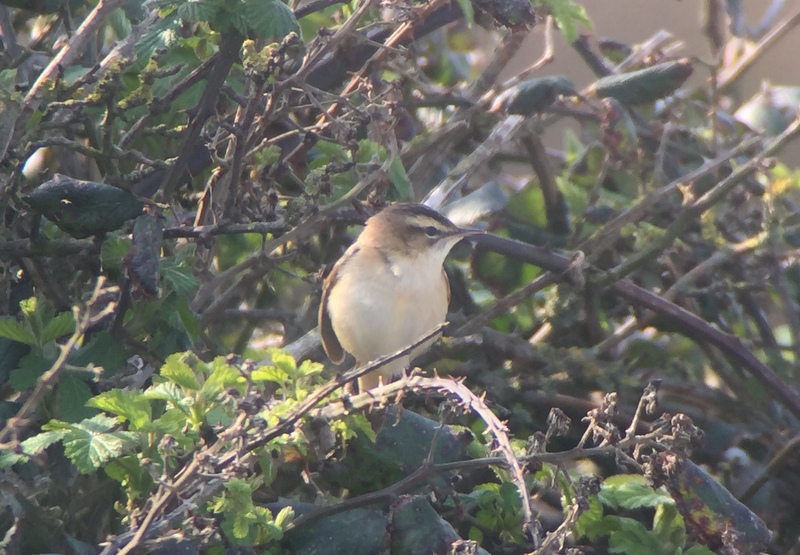 Sedge Warbler – two were singing in the bushes below the seawall
Sedge Warbler – two were singing in the bushes below the seawall
The tide was in out in the harbour and it was a big tide today, so that the saltmarsh was pretty much all covered. A few waders were braving it on the remaining islands – we could see a couple of Grey Plover and a little group of Black-tailed Godwit looking very smart now in their rusty summer plumage. When a Marsh Harrier flew low across the flooded saltmarsh, two Snipe flew up in alarm. They circled round a couple of times and only when the danger had passed did they eventually land back pretty much where they had taken off from.
A Bittern boomed once from the reeds further long, but it was hard to hear above the wind. Unfortunately it then went quiet and there was no sound when we got to where it had been booming. We heard a brief ‘ping’ from a Bearded Tit and got the briefest glimpse as one dropped down into the reeds, too quick for everyone to get on to. It was too windy today for Bearded Tits – they were keeping well down in the reeds today.
Just beyond the reeds, a big white shape out on one of the pools on the grazing marsh was a Spoonbill. We could see it, head down, sweeping its bill vigorously from side to side as it walked back and forth through the water. It was probably only exploring the pools here because the tide was so high in the harbour and unfortunately it didn’t linger long. We just got it in the scope for a few seconds before it took off.
 Spoonbill – feeding on one of the pools out on the grazing marsh
Spoonbill – feeding on one of the pools out on the grazing marsh
As the Spoonbill flew across in front of us, we got a good view of its long neck, held outstretched in flight (unlike the Little Egrets), and we could even see the spoon-shaped bill. It looked like it might be heading out over the saltmarsh, but then turned and dropped down behind the seawall, presumably heading for the pools near the path in the direction we had just come.
There is no shortage of Linnets here, and we could hear several flying past as we walked along. A male then perched up in the bushes on the edge of the saltmarsh and we got a better look at it, starting to develop a bit of reddish flush on the breast and on the patch above the bill.
 Linnet – perched in the bushes on the edge of the saltmarsh
Linnet – perched in the bushes on the edge of the saltmarsh
Out at the boardwalk, we turned east and headed into the dunes. We had hoped it might be more sheltered here, but the wind was still whistling through. At the first more sheltered area, we found a little group of Linnets feeding on the short turf. It was only when we walked a little further that we found a Wheatear. First one, then a couple more – two smart males, with bold black bandit masks, and a more subtle female.
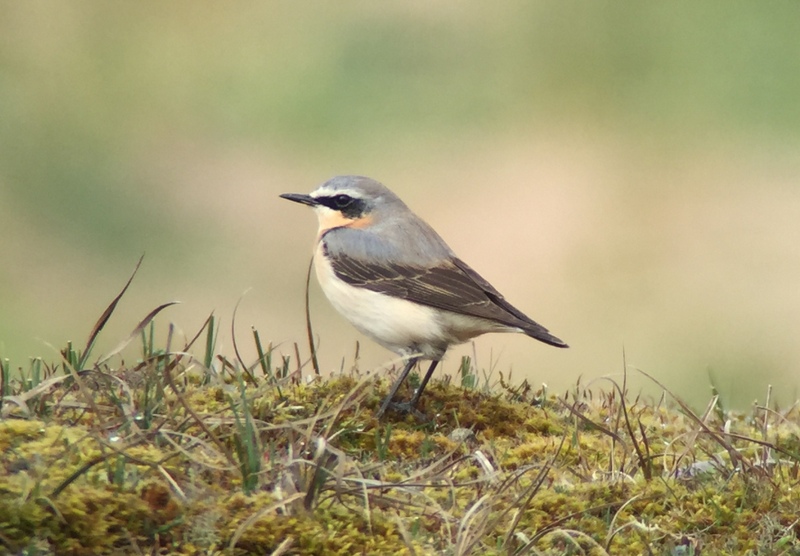 Wheatear – this photo from the dunes a few days ago
Wheatear – this photo from the dunes a few days ago
It was hard going walking into the wind, and the group did not want to walk too far today, so we decided to turn round and make our way slowly back. Another Wheatear flew across in front of us as we returned towards the boardwalk and two were then feeding on the short grass on the edge of the grazing marshes, along with a Skylark and a Goldfinch!
The tide had started to go out now, and a bit of dryish land was appearing out on the saltmarsh as the water level dropped. As well as lots of Black-headed Gulls, a few Brent Geese had returned to feed there. A quick scan revealed the friendly face of the winter resident Black Brant hybrid again. Subtly a shade or so darker in body plumage than our regular Russian Dark-bellied Brent Geese, it also sports a slightly bolder white flank patch. The progeny of a wandering Black Brant from NE Siberia / NW North America and one of our own Brent Geese, it returns to the same area to winter every year.
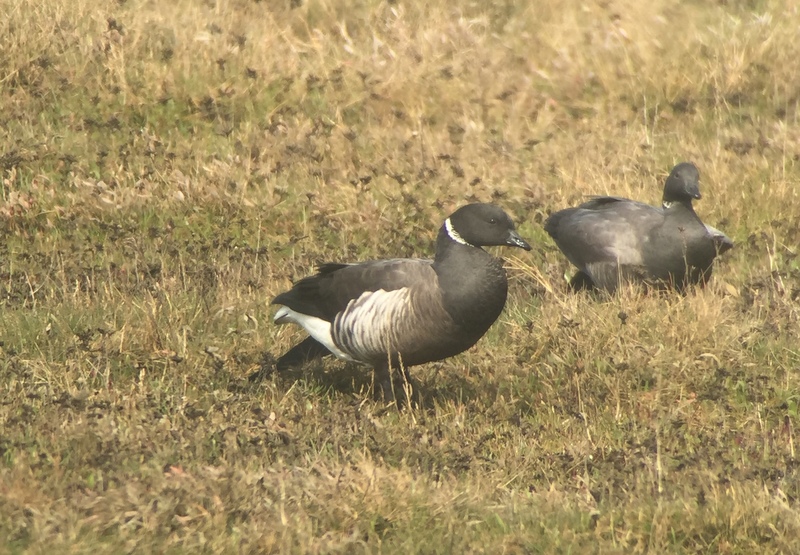 Black Brant hybrid – out on the saltmarsh again
Black Brant hybrid – out on the saltmarsh again
We stopped back at the reedbed again, but this time we climbed down the bank and stood at the bottom of the seawall, where it was less exposed to the wind and quieter. After a short wait, this time we could hear the Bittern booming properly. Perhaps understandly, it kept itself tucked well down in the reeds, as did the Bearded Tits. We heard one again, but they were obviously still keeping low out of wind.
A little further back, along the path across the marshes, we stopped to listen to a Chiffchaff singing. It sounded a little odd. Rather than a jaunty, alternating series of ‘chiffs’ and ‘chaffs’, this one repeated the same syllable several times in succession – ‘chaff-chaff-chaff, chiff-chiff-chiff’. It sounded slightly reminiscent of Iberian Chiffchaff, previously considered a race of our Chiffchaff but now treated as a species in its own right, but it wasn’t quite right for that either. it is suggested that Iberian Chiffchaff and Common Chiffchaff hybridise in Spain, but some Chiffchaffs just seem to pick up a little bit of Spanish language on their winter holidays. An interesting bird to listen to.
A request as to whether we might be able to see a Mediterranean Gull today saw us make a short diversion to a local Black-headed Gull colony. A few pairs of Mediterranean Gull nest in with them and it didn’t take us long to find one, despite the windy conditions. A smart adult, with jet black head extending further down the back of the head than the actually dark chocolate brown hood of the Black-headed Gull, and a heavier blood red bill. It then turned round to flash its white wingtips. A second Mediterranean Gull flew over the throng.
 Mediterranean Gull – in with the Black-headed Gulls
Mediterranean Gull – in with the Black-headed Gulls
After lunch, we drove west, cutting across inland to the Wash coast. Several Ring Ouzels have taken up temporary residence in paddocks at Snettisham, and after our longer walk this morning, this was a much easier place to get to. The Ring Ouzels were on show pretty much as soon as we arrived. The female appeared first, on the grass at the back. Much like a Blackbird, but with a conspicuous white gorget, the female’s is slightly brown tinged whereas the male’s is purer white. We watched her hopping about on the short grass, amongst the numerous Rabbits.
The female Ring Ouzel was spooked a couple of times and flew down into an overgrown ditch / hedge just behind. Coming out gingerly again a minute or so later back onto the grass. The second time she did so, we noticed the male Ring Ouzel in a bush in the hedge. The female flew up to join him and a Blackbird appeared next to them, just for comparison. While we were waiting for the Ring Ouzels to re-emerge, a couple of Lapwings also delighted us with some vigorous display flights, swooping and tumbling over the paddocks.
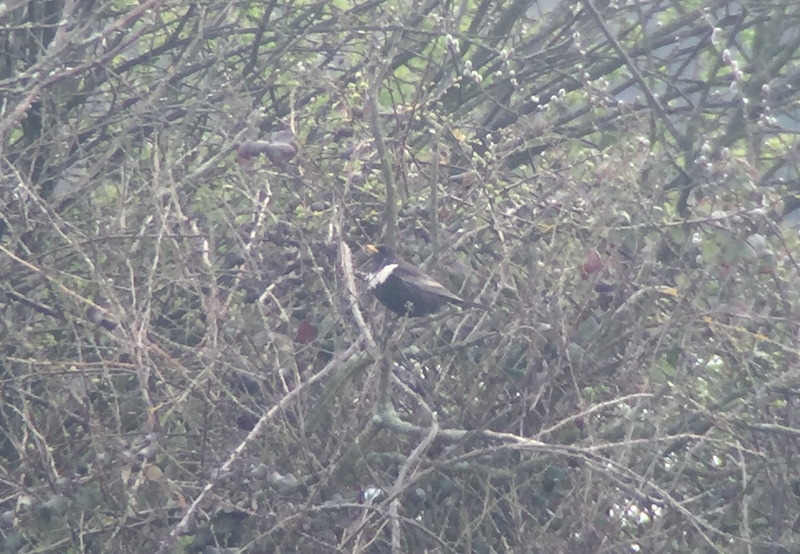 Ring Ouzel – the male flew up into the hedge
Ring Ouzel – the male flew up into the hedge
We had a gentle stroll into the south end of the Coastal Park. We could hear several Willow Warblers singing from deep in the bushes, but eventually we found one close to the path and watched it flitting around, appropriately enough in a young willow tree. There were lots of other warblers singing here too – Chiffchaffs, Sedge Warbler and a Blackcap are all returning migrants, but the Cetti’s Warbler is a resident, here all year round though more vocal now than through the winter and still very skulking.
From over towards the Wash, we could hear Golden Plover calling. Up on the seawall, we could see the tide was now a long way out. Right out on the edge of the water, we could just make out a huge oil slick of waders smeared across the mud. It was hard to make out any detail at this range, even through a scope, but we know they were mostly Knot, thousands and thousands of them. Nearby, a smaller and slightly more golden brown slick was the Golden Plover. Suddenly, something spooked them and all the waders took to the air. They all swirled round for a minute or two, making different shapes in the sky as they twisted and turned, alternately flashing white underwings in the sun and darker upperparts. It was obviously not a major alert as they quickly settled back down, but not before having treated us to a great display.
Walking back towards the car, we could hear Pink-footed Geese calling. We looked across to see six circling over the grazing marshes inland. As they turned, we could see their dark heads and small, mostly dark bills. These were the only Pink-footed Geese we saw today. Of the tends of thousands which spend the middle of the winter here, most have long gone, making their way back towards Iceland to breed via an extended stopover further north, perhaps in eastern Scotland. A smaller number linger here longer, but even these have mostly gone north now. In contrast, a couple of Swallows flying over were returning for the summer.
Back round along the coast at Holme, we parked by the seawall and walked out to the paddocks. A few Avocets were out on the saltmarsh pools, commuting from there back and forth towards Redwell Marsh. A Little Egret in one of the channels stopped to preen, showing us its ornate plumes which it develops in the breeding season – the two long ‘aigrettes’ down the back of the head blowing in the breeze and the puffy mass of feathers over the back and tail. These were the feathers for which the species was hunted extensively, particularly in the 19th Century.
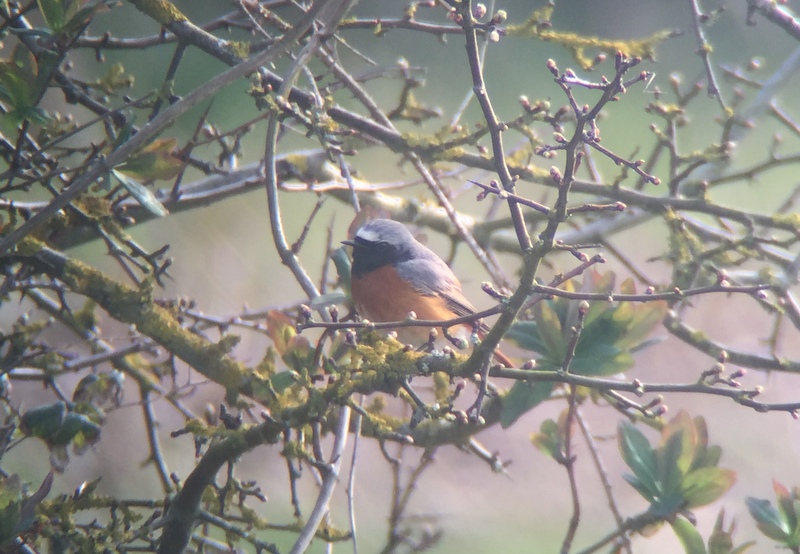 Redstart – still lingering in the paddocks
Redstart – still lingering in the paddocks
A Redstart has been frequenting the paddocks at Holme for a few days now. Like the Ring Ouzels, this bird is just taking a break here on its way north. As we rounded the corner, the first bird we saw in the paddocks was the Redstart, perched low on one side of a large hawthorn bush. It was a stunning spring male – black face, bright orange breast and belly, and grey back. Its white forehead shone in the afternoon sunshine when it turned to face us. It kept dropping down to the ground, looking for insects, flashing the orange-red tail from which it gets its name when it flew, before flying back up to the bush. We had a great view of it through the scope.
A Pied Flycatcher had been reported earlier in the day, further along at the Firs. Another classic spring migrant, stopping off here on its way, but this one probably fresh in this morning. We just had enough time still to make our way along there and see if we could find it. Thankfully, when we arrived in the car park there were a couple of friendly faces there and they pointed us straight to where the Pied Flycatcher was perched in a pine tree. Once again a smart male, mostly black above and white below but with a white flash in the wings and a blob of white on the forehead above the bill, slightly browner wing feathers suggested it was most likely a 1st summer male.
 Pied Flycatcher – stopped off in the pines at Holme
Pied Flycatcher – stopped off in the pines at Holme
We watched it flycatching, making frequent sorties out from the trees before flying back to a perch. It was mostly dropping down to ground, presumably finding more insects down there than flying round in the air in the later afternoon, even though it had tucked itself into a sheltered sunny spot in the trees. We had a great look at it – then it was time to call it a day and head back. As well as all the other things we had seen, it had been great to catch up with Wheatears, Ring Ouzels, Redstart and Pied Flycatcher all in a day – a classic day of early spring migrants here on the North Norfolk coast.
















